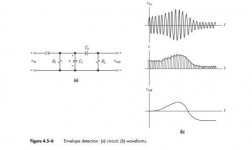سلام
دوستان مهندس
من باید برای سوال زیر پروژه شبیه سازی متلب رو انجام بدم ولی
فعلا بدلیل عدم تسلط کافی خواهشا در این زمینه بنده رو کمک فرمایید
سوال برای فصل 4 مخابرات کارلسون ویرایش 5 میباشد.

من نمونه فایل رو از یکی از دوستان گرفتم فقط کافیه که یه مقدار داخلش تغییر
ایجاد کنم و برای استاد ایمیل کنم
خواهشا دوستان اهل فن بنده رو کمک کنند و تغییرات را برای ینده اعمال کنند
چون کمتر از 2 ساعت وقت برای ارسال وقت هست.
ممنون
نمونه پروژه شبیه سازی شده با متلب:
دوستان مهندس
من باید برای سوال زیر پروژه شبیه سازی متلب رو انجام بدم ولی
فعلا بدلیل عدم تسلط کافی خواهشا در این زمینه بنده رو کمک فرمایید
سوال برای فصل 4 مخابرات کارلسون ویرایش 5 میباشد.
کد:
"> [COLOR=#231F20][FONT=Futura-Heavy][B]Envelope detection of suppressed carrier signals[/B]
[COLOR=#231F20][FONT= ]Write a MATLAB program that emulates the envelope detector of Fig. 4.5–6a to
[COLOR=#231F20][FONT= ]have it detect a 100 percent modulated AM signal and then a D SB signal. Show why
[COLOR=#231F20][FONT= ]it is not suitable for detection of DSB signals. Use a single-tone message and plot
[COLOR=#231F20][FONT= ]the message, modulated signal, and the envelope detector output.[/FONT][/COLOR][/FONT][/COLOR][/FONT][/COLOR][/FONT][/COLOR]
[/FONT][/COLOR]
من نمونه فایل رو از یکی از دوستان گرفتم فقط کافیه که یه مقدار داخلش تغییر
ایجاد کنم و برای استاد ایمیل کنم
خواهشا دوستان اهل فن بنده رو کمک کنند و تغییرات را برای ینده اعمال کنند
چون کمتر از 2 ساعت وقت برای ارسال وقت هست.
ممنون
نمونه پروژه شبیه سازی شده با متلب:
کد:
%show how an envelope detector demodulates AM and DSB signals
%Clear and initialize varables
clear
for t=1:2000
j(t)=t;
xc_am(t)=0; %AM signal
xc_dsb(t)=0; %DSB signal
v_am(t)=0; %Rectified AM signal
v_dsb(t)=0; %Rectified DSB signal
y_am(t)=0; %output of envelope detector
y_dsb(t)=0; %output of envelope detector
hlpf(t)=0; %LPF for envelope detector
end
j
fc=10^6; %carrier frequency is 10^6 Hz
fm=10^5; %message frequency is 10^5 Hz
Ts=1/(2*fc); %sample period is 1/(2*10^6) seconds
Ac=1.5; %carrier amplitude is 1.5
%Generate a signal-tone message
for t=1:2000
m(t)=cos(2*pi*fm*t*Ts);
end
%Generate AM and DSB modulated signals
for t=1:2000
xc_am(t)=Ac*(1+m(t))*cos(2*pi*fc*t*Ts);
xc_dsb(t)=Ac*m(t)*cos(2*pi*fc*t*Ts);
end
%Generate impulse response function for fifth order Butterworth
for t=1:2000
hlpf(t)=(250000*exp(-t))/131981 - (309*exp(-(809*t)/1000)*(cos((3*38391^(1/2)*t)/1000) - (1309*38391^(1/2)*sin((3*38391^(1/2)*t)/1000))/186327))/191 - (191*exp(-(309*t)/1000)*(cos((904519^(1/2)*t)/1000) + (809*904519^(1/2)*sin((904519^(1/2)*t)/1000))/250019))/691;
end
%Demodulate the AM and DSB signals using an envelope detector
%Rectify AM and DSB signals
for t=1:2000
if xc_am(t)>=0
v_am(t)=xc_am(t);
end
if xc_dsb(t)>=0
v_dsb(t)=xc_dsb(t);
end
end
%Low pass filter rectified signals via convolving with LPF
y_am=conv(hlpf,v_am);
y_dsb=conv(hlpf,v_dsb);
%Remove DC offset from signals [this function as the blocking capacitor]
%calculate DC offset by determining average value of signal
dc_am=0;
dc_dsb=0;
for t=1:2000
dc_am=dc_am+y_am(t);
dc_dsb=dc_dsb+y_dsb(t);
end
dc_am=dc_am/2000;
dc_dsb=dc_dsb/2000;
%subtract DC offset
for t=1:2000
y_am(t)=y_am(t)-dc_am;
y_dsb(t)=y_dsb(t)-dc_dsb;
end
%Scale the message amplitudes
y_am=5*y_am/max(y_am);
y_dsb=5*y_dsb/max(y_dsb);
m=2*m/max(m);
%plot the modulated demodulated signals and original message and include
%adding offsets of 20,15,10,5 and 0 to signal amplitudes to enable them to
%fit on a signal figure
plot(j(1:150),xc_dsb(1:150)+20,j(1:150),y_dsb(1:150)+15,j(1:150),xc_am(1:150)+10,j(1:150),y_am(1:150)+5,j(1:150),m(1:150))